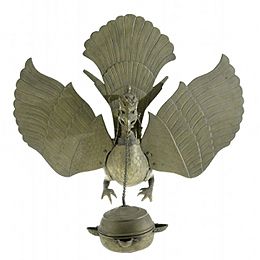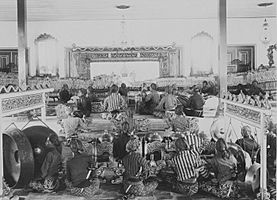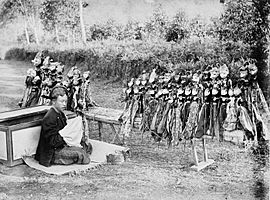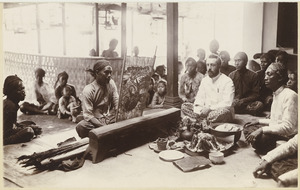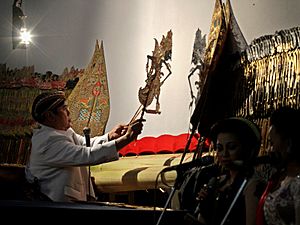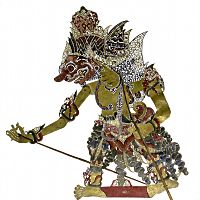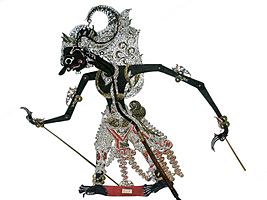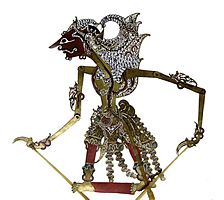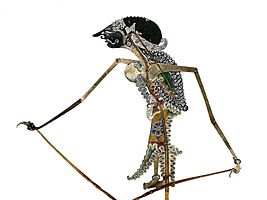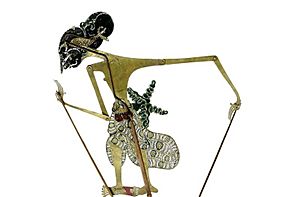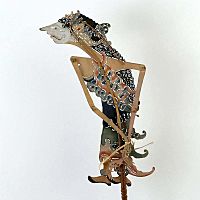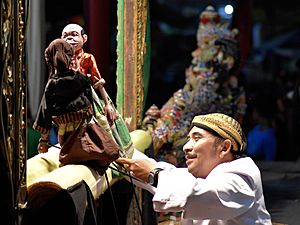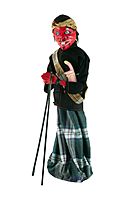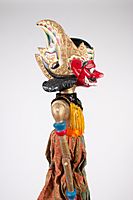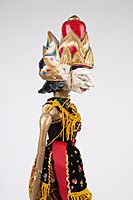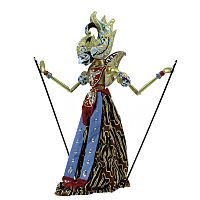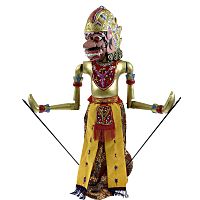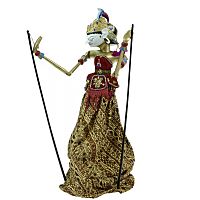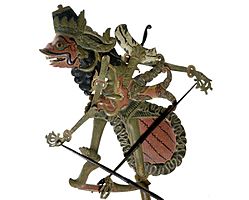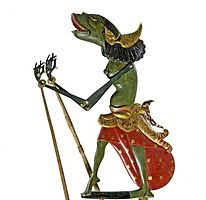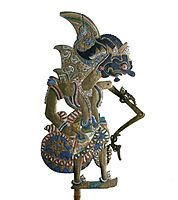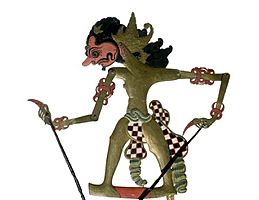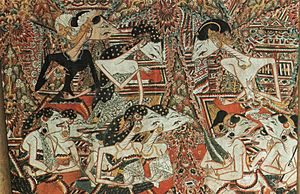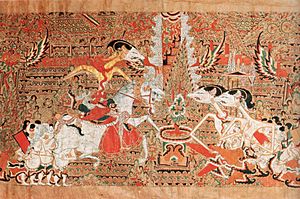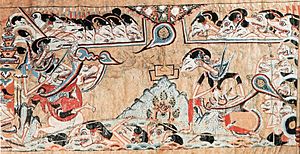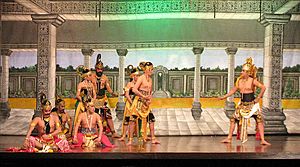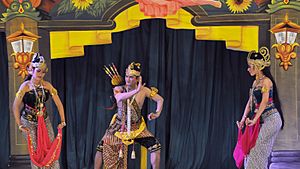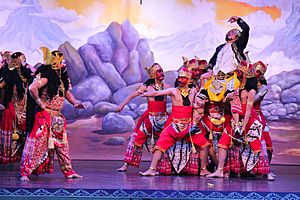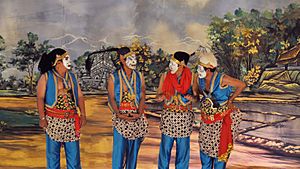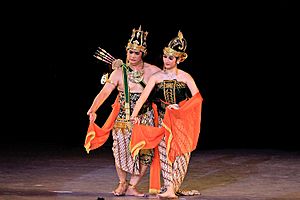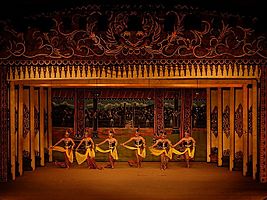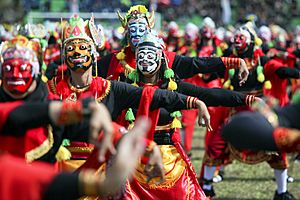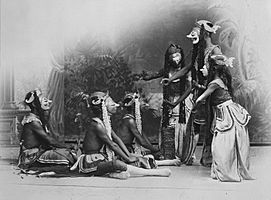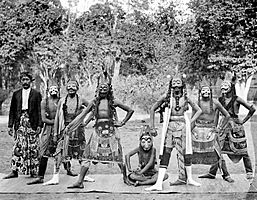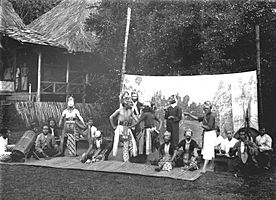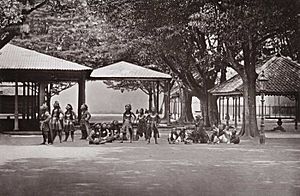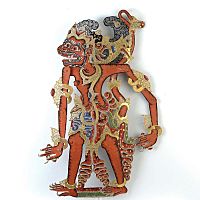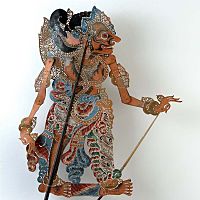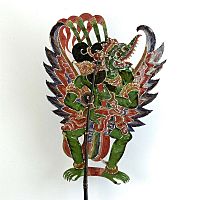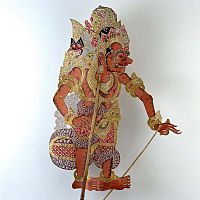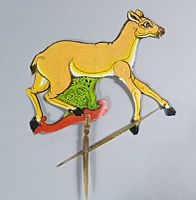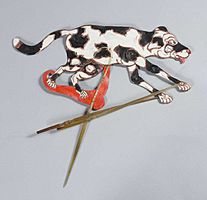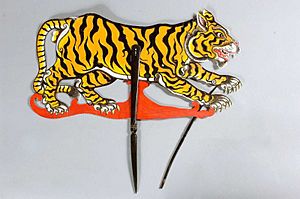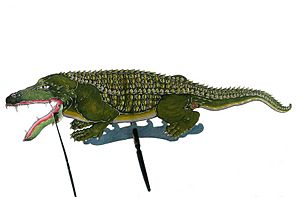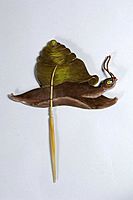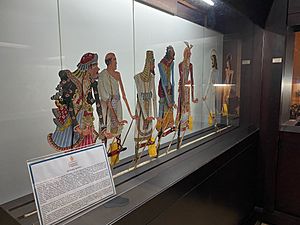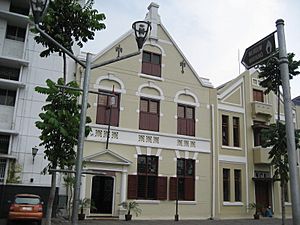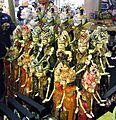Wayang facts for kids
Quick facts for kids Wayang |
|
|---|---|
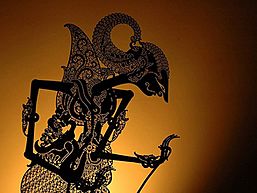 |
|
| Types | Traditional puppet theatre |
| Ancestor arts | Javanese people |
| Originating culture | Indonesia |
| Originating era | Hindu - Buddhist civilisations |
| Wayang Puppet Theatre | |
|---|---|
|
UNESCO Intangible Cultural Heritage
|
|
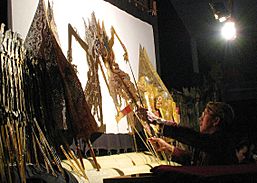
Wayang kulit performance by the famous Indonesian dalang (puppet master) Manteb Soedharsono, with the story "Gathutkaca Winisuda", in Bentara Budaya Jakarta, Indonesia, on 31 July 2010
|
|
| Country | Indonesia |
| Criteria | Performing arts, Traditional craftsmanship |
| Reference | 063 |
| Region | Asia and the Pacific |
| Inscription history | |
| Inscription | 2008 (3rd session) |
| List | Representative List |
 Wayang Kulit (the leather shadow puppet), Wayang Klithik (the flat wooden puppet), Wayang Golek (the three-dimensional wooden puppet) |
|
Wayang (also spelled wajang) is a very old and special kind of puppet show from Java, an island in Indonesia. The word Wayang can mean the whole show or sometimes just the puppet itself. These shows are usually performed with a gamelan orchestra, which plays traditional Indonesian music.
The stories in Wayang shows often come from old myths and legends. Many are based on famous Hindu stories like the Ramayana and the Mahabharata. They also tell local Indonesian tales. Traditionally, a Wayang show lasts all night, from midnight until dawn! A special artist and leader called a dalang performs the show. People can watch from both sides of the screen.
Wayang shows are still super popular in Indonesia, especially in Java and Bali. They are often part of important events like religious ceremonies, weddings, or even national holidays. Sometimes, they are performed for tourists to share this amazing culture. Wayang is more than just a show; it includes acting, singing, music, drama, and beautiful art like painting and carving. It's also a way to share information, teach lessons, and entertain people.
In 2003, UNESCO recognized Wayang as a "Masterpiece of the Oral and Intangible Heritage of Humanity." This means it's a very important cultural treasure that needs to be protected.
Contents
What Does Wayang Mean?
The word Wayang comes from the Javanese language. It means 'shadow' or 'imagination'. In Indonesian, a similar word is bayang. So, Wayang can refer to the shadows made by the puppets or the imaginative world of the show. Today, it can mean the puppet itself or the entire puppet theatre performance.
The Long History of Wayang
Wayang is a very old way of telling stories in Indonesia. It's known for its detailed puppets and complex music. The first signs of Wayang date back to the late 900s CE. People have different ideas about where Wayang started. Some think it began in Java, while others believe it came from India or China.
Many experts, like James R. Brandon, believe Wayang truly grew into its own unique art form in Java. They say that Wayang is deeply connected to Javanese culture and religious life. The puppets and how they are used are very different from shadow puppetry found in other parts of Asia. Also, many of the special words used in Wayang are Javanese, not from other languages like Sanskrit.
Some believe Wayang might have come from India because Hinduism and Buddhism arrived in Indonesia from there a long time ago. India also has old puppet traditions that use leather puppets, similar to some Wayang styles. Plus, some characters in Wayang stories are like those found in ancient Indian plays.
Earliest Records of Wayang
The oldest known mention of Wayang is from the 800s CE. An old Javanese writing from around 840 CE talks about different performers, including aringgit, which means 'Wayang puppet show'. Another record from 903 CE describes a puppet show for gods, telling a story about the hero Bhima from the Mahabharata.
In 1035 CE, a poet named Mpu Kanwa wrote about a Wayang screen, comparing life to a Wayang performance. This shows that Wayang was already a well-known and important art form in Java a very long time ago.
Wayang kulit is a special type of theatre that uses light and shadows. The puppets are made from buffalo hide and held up by bamboo sticks. When a light shines on them from behind a white cloth, their shadows appear on the screen. The stories are often romantic tales and religious legends, especially from the Mahabharata and the Ramayana. Some plays also tell local Javanese stories.
- Wayang puppet theatre performances in Indonesia
-
Wayang kulit performance with gamelan music in Yogyakarta, between 1900 and 1940.
-
Wayang Beber performance in Yogyakarta, Dutch East Indies, in 1902.
Different Kinds of Wayang Art
There are several types of Wayang, each with its own unique style.
Wayang Kulit: Shadow Puppets
Wayang kulit are the most famous Indonesian Wayang puppets. Kulit means 'skin' in Javanese. These puppets are made from carefully carved leather. They have buffalo horn handles and rods to control them. They are painted in beautiful colors, often with gold details. The stories usually come from the Hindu epics, the Ramayana and the Mahabharata.
In Javanese Wayang, there's a group of characters called punokawan. They are like funny servants or clowns who help the hero. They also add humor and wise thoughts to the show. These characters, like Semar and his sons Gareng, Petruk, and Bagong, were added to the stories later and are not from the original Hindu epics. They often talk about local news and current events in a funny way.
The style of the puppets changes depending on the region. In Central Java, the cities of Surakarta (Solo) and Yogyakarta are famous for their Wayang traditions. Bali has puppets that look more realistic. Sometimes, modern things like bicycles or cars are added for laughs, but mostly, the puppet designs have stayed the same for hundreds of years.
In the past, the shadows were made by an oil lamp. Today, electric lights are often used in Java, but Bali still uses traditional firelight. Making a Wayang kulit puppet is a lot of work. Artists work together for weeks to carve, smooth, paint, and assemble each puppet. It's a very detailed process that requires great skill.
- Some examples of ''Wayang kulit'' figures (leather shadow puppet)
-
Princess Shinta, before 1983.
Wayang Golek: Wooden Rod Puppets
Wayang golek are three-dimensional wooden puppets. They are controlled from below using a wooden rod that goes through their body to their head, and sticks connected to their hands. These puppets can move very expressively, almost like human dancers. Wayang golek is mostly found in West Java, especially with the Sundanese people. In Central Java, these wooden puppets are also called Wayang menak.
Historians think Wayang golek might have come from China and arrived in Java around the 1600s. Some of the oldest Wayang golek traditions are from the north coast of Java. These areas were home to early Muslim kingdoms in Java. It's believed that Wayang golek became popular by telling stories of Amir Hamza, the uncle of Muhammad. These stories are still performed today.
In the 1700s, Wayang golek moved into the mountains of West Java. There, it started telling stories from the Ramayana and the Mahabharata. This style is now called Wayang golek purwa and is very popular. While the main characters are similar to Wayang kulit, some of the funny servant characters have Sundanese names and traits.
- Some examples of ''Wayang golek'' figures (3D wooden puppet)
-
Rahwana, Indonesia in 2004.
Wayang Klitik: Flat Wooden Puppets
Wayang klitik (also called Wayang karucil) are a mix between Wayang golek and Wayang kulit. They are made from thin pieces of wood, like Wayang kulit are made from leather. They are also used as shadow puppets and are smaller, similar in size to Wayang kulit figures.
Because they are made of wood, Wayang klitik puppets can break easily, especially during battle scenes. This often makes the audience laugh! To make them stronger, puppets used in battle scenes often have leather arms. The name klitik-klitik comes from the sound the puppets make when the dalang moves them.
Wayang klitik puppets originally came from East Java. The stories they tell are from old East Javanese kingdoms like Jenggala, Kediri, and Majapahit. Popular stories include those of Raden Panji and Damarwulan. The Damarwulan story is full of love and battles, and it's very popular. The dalang often adds local gossip and jokes to the play to make it even funnier.
- Some examples of ''Wayang klithik'' figures (flat wooden puppet)
-
Demon, before 1950.
Wayang Beber: Scroll Paintings
Wayang beber uses painted scrolls to tell stories. The dalang unrolls the scrolls one by one as they narrate each part of the story. This is similar to how some storytellers in medieval Europe used illustrated scrolls.
Chinese visitors to Java in the 1400s described storytellers who unrolled scrolls and made audiences laugh or cry. A few old scrolls still exist today in museums. There are also two sets of hand-painted scrolls owned by families in Central Java, passed down through many generations.
During a Wayang beber performance, a small gamelan orchestra plays music. The dalang unrolls the first scroll and then tells that part of the story by speaking and singing. They continue unrolling scrolls throughout the evening. Each scene on the scrolls shows a different part of the story. The stories often come from the Panji romances, which are old legends from East Javanese kingdoms.
- Some examples of ''Wayang beber'' scenes
-
Final fight in alun-alun in Kediri, East Java. Tawang Alun kills Klana. Indonesia 17th century.
-
Princess Sekar Taji, mbok Kili (left), and Ganda Ripa or Panji (right) in the palace in Kediri, 17th century.
-
Competition between Panji Sepuh (left) and Jaya Puspita (right), 18th century.
Wayang Wong: Human Wayang
Wayang wong (also called Wayang orang) means 'human Wayang'. In this type of performance, human actors dress up and move like the puppets. They also include dance in their dramatic shows. Wayang wong typically tells stories from the Ramayana or the Mahabharata.
- Some examples of ''Wayang wong'' scenes
-
Pandava and Krishna in a Wayang wong performance.
-
King Duryodana in a Wayang wong performance in Semarang, Jawa Tengah, Indonesia.
Wayang Topeng: Masked Wayang
Wayang topeng (or Wayang gedog) shows use themes from the Panji stories. The performers wear masks, which are called Wayang topeng or Wayang gedog. The word gedog comes from kedok, which means 'mask'.
Wayang gedog focuses on a love story between Princess Candra Kirana of Kediri and Raden Panji Asmarabangun of Janggala. They are seen as incarnations of Hindu gods of love. Their story is called Smaradahana ('The fire of love'). After many adventures, they finally get married. Originally, Wayang wong was only for royal entertainment, but over time, it became popular with everyone.
- Some examples of ''Wayang topeng'' scenes
-
Wayang topeng in Java.
-
Wayang topeng in Java.
-
Wayang topeng in Java.
Stories Told in Wayang
Wayang characters and stories come from different groups of tales. The most popular and oldest are from Wayang purwa.
Wayang Purwa: Ancient Stories
Wayang purwa means 'ancient Wayang'. These stories are based on the Hindu epics, the Ramayana and Mahabharata. They are usually performed as Wayang kulit, Wayang golek, or Wayang wong dance dramas.
Some popular Wayang kulit characters from Central Java include:
- Heroes (Satriya): Bhima, Arjuna, Ghatotkaca, Abimanyu.
- Kings (Raja): Rama Wijaya, Kresna, Yudhistira.
- Gods (Dewa): Batara Guru, Wisnu.
- Wise Teachers (Resi): Anoman, Bhisma, Durna.
- Princesses (Putri): Sinta, Drupadi, Srikandi.
- Servants/Clowns (Punakawan): Semar, Gareng, Petruk, Bagong.
- Giants/Demons (Raksasa): Kumbakarna, Dasamuka.
- ''Wayang purwa'' figures from Balinese ''Wayang kulit''
-
Wayang kulit (shadow puppet) Sangruda, before 1900.
Wayang Panji: Javanese Legends
These stories come from the Panji cycles, which were created in Java during the Kediri Kingdom. They are set in the Javanese kingdoms of Janggala and Panjalu (Kediri). These stories are often performed as Wayang gedog (masked Wayang) and Wayang wong dance dramas.
- Raden Panji (also known as Panji Asmoro Bangun)
- Galuh Chandra Kirana (also known as Sekartaji)
Wayang Menak: Islamic Hero Stories
Wayang menak puppet plays tell the brave adventures of Wong Agung Jayengrana, who is based on the Muslim hero Amir Hamzah. These stories have been performed in Java and Lombok for hundreds of years. They are mostly done with Wayang golek (wooden rod-puppets).
The word menak is a Javanese title for people who are respected for their good character, even if they are not born into royalty. Jayengrana is a character who inspires loyalty because he is selfless and devoted to his faith. He and his followers fight against pagan faiths that threaten their peaceful kingdom.
The character of Amir Hamzah is loosely based on a real historical person, Hamza ibn Abdul-Muttalib, who was the uncle of Muhammad. He was a strong warrior. The stories traveled from Persia to India and then to Southeast Asia.
Wayang Kancil: Animal Fables
Wayang kancil is a type of shadow puppet show where the main character is a clever mouse deer (kancil) and other animals. These stories are like fables, often taken from old Indian and Javanese tales.
Wayang kancil was created around the late 1400s and was used to teach about Islam. The stories are very popular with children because they are funny and teach good lessons. Wayang kancil puppets are made from buffalo skin, just like Wayang kulit. The shows are also accompanied by a gamelan orchestra. The language used depends on the audience; for children, the puppeteer usually uses simpler Javanese.
The puppets are carved and painted to look realistic. They show animals like tigers, elephants, crocodiles, and birds. There are also a few human characters, like a farmer and his wife. A full set of Wayang kancil puppets usually has about 100 pieces.
- ''Kancil'' figures in ''Wayang kulit''
Other Wayang Stories
While most Wayang kulit shows tell Hindu epics, some modern forms have appeared. In the 1960s, Wayang wahyu was created by a Christian missionary to share Bible teachings in a way that Javanese people could understand. Similarly, Wayang sadat uses Wayang to teach about Islam, and Wayang pancasila uses it for national politics.
There have even been attempts to tell modern stories using Wayang art, like the Star Wars saga, performed by artists in Malaysia.
Wayang's Cultural Importance
Wayang was first used for rituals to connect with ancestral spirits. Over time, it became a way to communicate important messages in society. Wayang plays often teach about education, culture, and philosophical ideas. It's a great way to share information and lessons. Wayang was used to spread religions like Hinduism and Islam. Because Wayang puppets are so flexible, they are still used today for many different purposes.
Wayang's functions can be grouped into three main ideas:
Tatanan: Norms and Values
Wayang shows can include all parts of human life, like ideas about society, culture, and laws. The puppets themselves represent rules or ways of behaving that teach about ethics and morals. These rules are agreed upon and guide the artists. The Wayang show has its own rules for how the puppets are handled and how the story is told. These traditions have been passed down for generations.
Wayang is a teaching tool that focuses on building good character. It helps people learn to have good behavior.
Tuntunan: Guidelines for Life
Wayang is a way to communicate in society. It helps people understand traditions, connect with their community, and share important values. Wayang teaches character education not just through the story, but also through the characters themselves. Each Wayang character can show different human traits. From the puppets, you can learn about leadership, courage, honesty, and sincerity. You can also see negative traits like greed, jealousy, and cruelty.
Tontonan: Entertainment for Everyone
Wayang puppet shows are a form of entertainment (tontonan) for the community. Wayang performances are still very popular, especially in Java and Bali. They are often shown on TV, radio, YouTube, and other social media. Wayang shows combine many arts like drama, music, dance, literature, and visual arts. The conversations between characters, the storytelling, and the music are all important parts of a Wayang performance.
The Artists Behind Wayang
Dalang: The Puppet Master
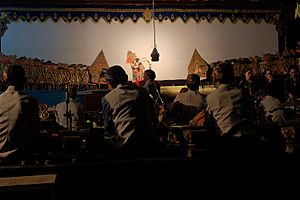
The dalang is the puppet master who performs the show. They sit behind the screen, sing, and tell the dialogues for all the different characters. With a traditional orchestra playing in the background, the dalang changes their voice to create excitement and drama. The play usually ends with good winning over evil. The dalang is highly respected in Indonesian culture for their knowledge, artistic skill, and spiritual understanding. They bring the old stories to life.
Wayang is one of the oldest and most popular forms of puppet theatre in the world. Hundreds of people will stay up all night to watch famous dalang performers. Some of the most well-known dalang in recent times include Ki Nartosabdho, Ki Anom Suroto, Ki Asep Sunandar Sunarya, and Ki Manteb Sudarsono.
Sindhen: The Singer
A sindhen (or pesindhén) is a woman who sings along with the gamelan orchestra. She is usually the only singer. A good sindhen needs to be a great communicator and have excellent singing skills. The word sindhen comes from a Javanese word meaning 'rich in songs'. In the past, the sindhen was often the only woman performing in a Wayang show.
Wiyaga: The Musicians
Wiyaga (also called niyaga or nayaga) refers to the group of people who play the gamelan orchestra. They have special skills in playing these traditional instruments, especially when accompanying ceremonies and performances like Wayang.
Wayang Museum
The Wayang Museum is located in the old city area of Kota Tua Jakarta in Jakarta, Indonesia. It's right next to the Jakarta Historical Museum.
This museum has many different types of Indonesian Wayang puppets, including Wayang kulit, Wayang golek, Wayang klithik, Wayang suket, and Wayang beber. It also has collections of masks (topeng), gamelan instruments, and Wayang paintings. The museum even has puppets from other countries like Malaysia, Thailand, Cambodia, China, India, and Turkey.
Images for kids
-
A Wayang kulit set and a gamelan ensemble collection at the Musical Instrument Museum, Phoenix, Arizona, United States.
-
A Wayang show in Java, Indonesia, featuring a Wayang puppet.
-
Sundanese Wayang golek (3D wooden puppet), Indonesia.
-
A Wayang klithik (flat wooden puppet) performance with a gamelan orchestra in Ngandong, Java, in 1918.
-
Wayang golek performance in Yogyakarta.
See also
 In Spanish: Wayang para niños
In Spanish: Wayang para niños
- Wayang kulit
- Wayang golek
- Wayang beber
- Culture of Indonesia
- Javanese culture
- Gamelan
- Wayang Museum


